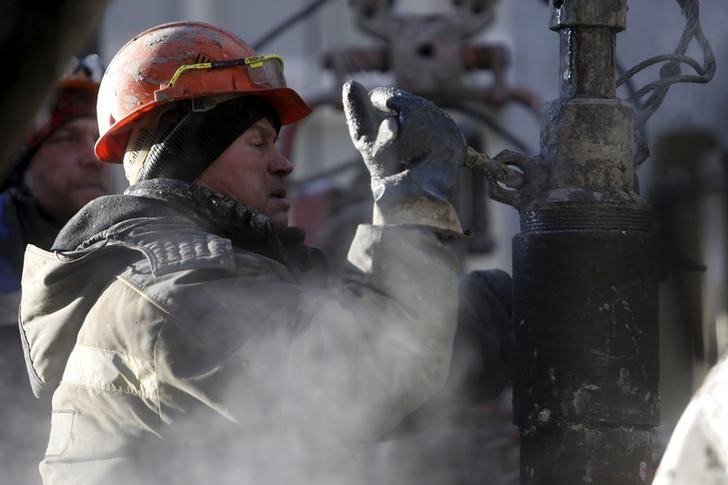By Stefanie Eschenbacher
MEXICO CITY (Reuters) – Mexico’s incoming President Claudia Sheinbaum will likely face a new challenge fulfilling the dream of energy independence that led her predecessor to spend $17 billion on a new refinery: a shortfall in domestic crude supply.
The country is a major crude producer but output from the country’s older oil fields, mostly in the Gulf of Mexico, has slumped to more than a four-decade low.
Without significant spending on exploration and production, Mexico may find itself importing crude to feed its expanded refinery capacity in the next decade, a once unheard-of change of direction for the key global exporter.
For years, state-owned Pemex has failed to meet local fuel demand because its outdated refineries were unable to process the heavy Maya crude that it predominantly pumps.
That left Mexico exporting crude while having to import gasoline and diesel, much of it from the United States. Outgoing President Andres Manuel Lopez Obrador vowed to change what he saw as a humiliating dependence on imported motor fuels.
He commissioned a new 340,000 barrels per day (bpd) refinery in his home state Tabasco to meet the fuel supply shortfall caused by Pemex’s six refineries that had gone decades without sufficient investment to run at capacity.
Lopez Obrador’s Olmeca refinery in Dos Bocas is over budget and behind schedule, but once it fully starts, Mexico may come close to supplying the motor fuels it consumes for a few years.
Previously unreported projections from the energy ministry, seen by Reuters, however, suggest that period would be short-lived, and Pemex would likely have to start importing crude as production will rapidly decline from 2030.
Pemex, the energy ministry and the president’s office did not respond to requests for comment for this story.
Zama, a shallow-water field on the cusp of being a deep-water field, and Trion, an ultra-deep-water field, would temporarily lift production to almost 2.247 million bpd in 2028 from around 1.8 million bpd now, the middle of three scenarios laid out by the energy ministry showed.
The most optimistic scenario sees output reaching 2.390 million bpd, and the more pessimistic at 2.164 million bpd.
All three scenarios, which factor in some new discoveries, project rapidly declining production from 2030.
That means Mexico would have to start importing crude as early as in the next decade if it wants to run its refineries near capacity, one source at the energy ministry familiar with the projections said. It would also no longer export crude.
Zama and Trion could also disappoint, the source said, adding that other recent discoveries have.
UNEXPLORED POTENTIAL
Alma America Porres, who served two terms as a commissioner at the hydrocarbon regulator, including during the landmark energy reform that sought to open up the sector a decade ago, said Mexico’s proven crude reserves suggest the shortfall may come even sooner.
“The proven reserves give us the most realistic picture of what there is,” she said. “I don’t see a big discovery, one of the scale of Trion or Zama, in the near term.”
Earlier this year, Mexico reported that its proven crude reserves had fallen to 5.978 billion barrels from 6.155 billion barrels a year earlier. Its overall proven reserves were lifted by , though.
Production from older fields – including the Cantarell field, once the second largest in the world after Ghawar in Saudi Arabia – has been declining rapidly in recent years. Newer fields have failed to compensate.
Lopez Obrador has invested heavily in the six refineries, which increased processing to about 1 million bpd. Even so, its outdated refineries produce record amounts of fuel oil rather than much-needed motor fuels.
With the Olmeca refinery starting up and repairs to older ones, the energy ministry forecasts they will process 1.6 million bpd of crude, closer but still below consumption levels of around 1.7 million bpd, International Energy Agency data shows.
Experts have said the huge sums spent on the Olmeca refinery could have been better spent on oilfield exploration and production, and diversifying into renewable energy sources.
Lopez Obrador, a resource nationalist, has not held auctions for areas that could encourage other oil and gas companies to explore and invest in deepwater and onshore shale production, where Pemex lacks expertise and money.
The legal framework to allow participation from companies to operate fields on their own – or in association with Pemex – remains in place even after Lopez Obrador pushed through other reforms that prioritize Pemex.
“The exploration part requires a lot of investment, investment that Pemex doesn’t necessarily have money for,” said Carla Gabriela Gonzalez, another former senior official at the hydrocarbon regulator.
“And that was where private companies added value: because they invested in exploration, and that investment didn’t cost the Mexican state anything. On the contrary, these companies paid the Mexican state for the right to explore.”
Three Pemex engineers at the company’s exploration and production arm, and the engineer at the energy ministry agreed that the state company could hugely benefit from participation by the private sector.
“What we need is a massive exploration strategy, just like Petrobras in Brazil had, instead of one that centers on increasing refining capacities,” said the energy ministry source.
Pemex puts Sheinbaum in a bind: she has positioned herself as the guardian of her mentor’s resource nationalist legacy that requires investment while others are diversifying into renewable energy sources.
Sheinbaum has proposed spending more on wind and solar infrastructure for electricity generation. Her plans for Pemex remain unclear and her team did not respond to a request for further comment.
With a doctorate in energy engineering from Mexico’s National Autonomous University, Sheinbaum was one of the lead authors for the industry chapter of the U.N. Intergovernmental Panel on Climate Change in 2014.
One of Sheinbaum’s advisors on energy matters said that there would likely be some collaboration with private companies during her presidency to increase exploration and production, with preference given to those already operating in Mexico.
Read the full article here


